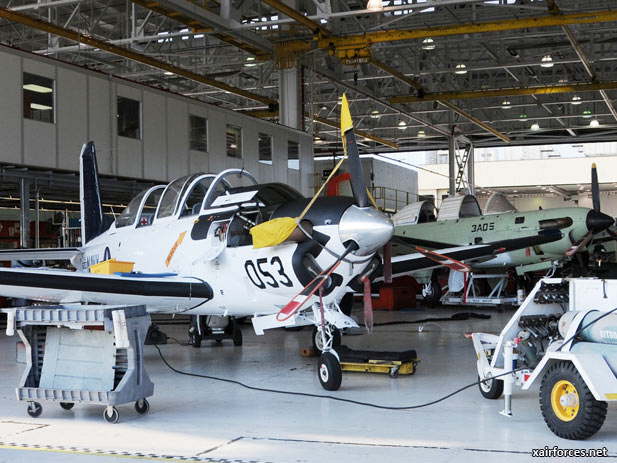
U.S. Naval Training Air Wing T-34C Turbomentor Trainer Aircraft Gets 5-Year Checkup/Makeover at FRCSE

Fleet Readiness Center Southeast (FRCSE) completed painting its first T-34C Turbomentor Trainer aircraft for a California-based detachment aligned under Commander, Strike Fighter Wing Pacific (CSFWP) July 31.
FRCSE painters completed the aircraft’s unique paint scheme by applying primer and a white topcoat with blue and black markings to protect the airframe from water intrusion and corrosion.
The unpressurized two-seat, turboprop trainer is used primarily to train student pilots; however, at CSFWP Detachment El Centro, Calif., the aircraft provides logistical air observation support to visiting squadrons operating at the detachment.
Artisans are currently performing an Aircraft Condition Inspection (ACI) due every 5 years between fleet tour cycles according to Steve Gibbs, an FRCSE aircraft planner and estimator.
“This particular T-34 entered Naval service in February 1981,” he said. “It served three tours with Training Air Wing Five at Naval Air Station Whiting Field in Florida from March 1983 to April 1994, followed by 6 years with NASA before being transferred in March 2002 to El Centro in a continuing support role.”
Each aircraft is flown between 1800 to 2200 flight hours before an ACI is due according to Gibbs. Artisans conduct nondestructive inspections on the primary structure points to detect cracks and corrosion. They remove and inspect the wings, as well as the vertical and horizontal stabilizers.
In addition, artisans replace time-compliance components, such as the landing gear, large wing attachment bolts and most mechanical components. They also update the aircraft to the latest configuration using maintenance engineering directives and manuals.
“If our artisans run into a problem that’s outside the maintenance manual, they submit a Request for Engineering Instruction,” said Gibbs. “The assigned engineering group will determine the appropriate repair action usually through stress analysis and then issue formal repair instructions. We average six to seven requests per aircraft not including any required lab work, such as paint removal by mechanical or chemical means.”
Prior to November 2011, the T-34 fleet was exclusively maintained by a defense contractor with a Federal Aviation Administration (FAA) repair certification to perform organizational, intermediate and depot-level maintenance under a Contract Logistic Support (CLS) agreement. Depot-level repairs were subcontracted to a higher-level maintenance facility in the private sector.
David Pfeffer, the primary/multi-engine team lead, said the material condition of the T-34 fleet had degraded over three decades due to the effects of prolonged wear and tear.
Naval Air Systems Command Program Manager Air (PMA) 273 worked closely with the FRCSE Industrial Business Office to recapture the depot-level inspection, modifications, and repair work at the military’s organic depot in an effort to raise maintenance standards on these T-34C aircraft that are already at or near their predicted fatigue lives.
“We were seeing higher levels of spending for ‘over and above’ repairs due to the material condition of these aging aircraft,” said Pfeffer. “PMA has been supportive, providing the additional funding to perform the required work to bring these old airframes back into better shape.”
Corrosion on the wing spars has degraded the material condition of the trainer aircraft. The spars must be replaced every three to five years, which is a costly and time-consuming process. The T-34 depot-level repairs and modifications will reduce future maintenance costs and improve readiness of the trainer platform.
Repairs to the California-based T-34 trainer are scheduled for completion at the end of August.
Source: JACKSONVILLE, Fla. | Naval Air Systems Command (NAVAIR) News - 12 August 2012
Photo: The U.S. Naval Training Air Wing T-34C Turbomentor Trainer Aircraft to Commander, Strike Fighter Wing Pacific (CSFWP) dries in a paint hangar at Fleet Readiness Center Southeast July 30. The aircraft provides logistical air observation support to CSFWP squadrons operating in El Centro, Calif. (Photo by U.S. Navy photo)
(12.08.2012)
|